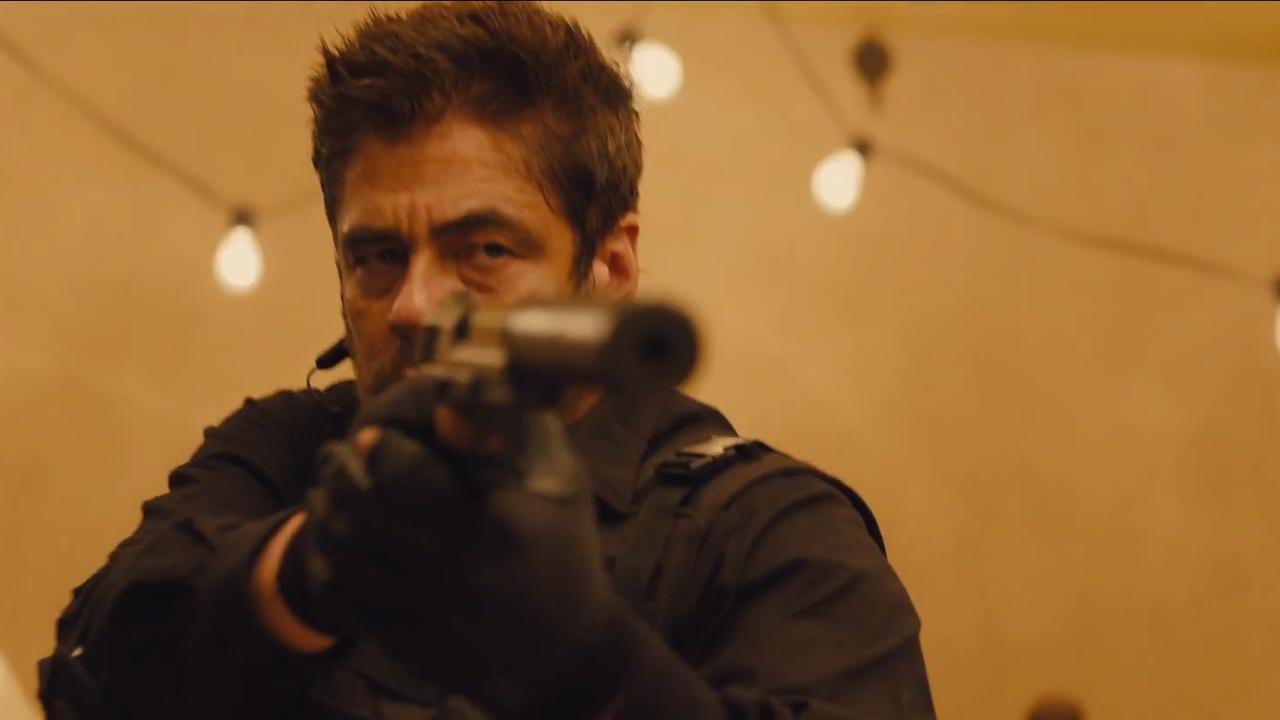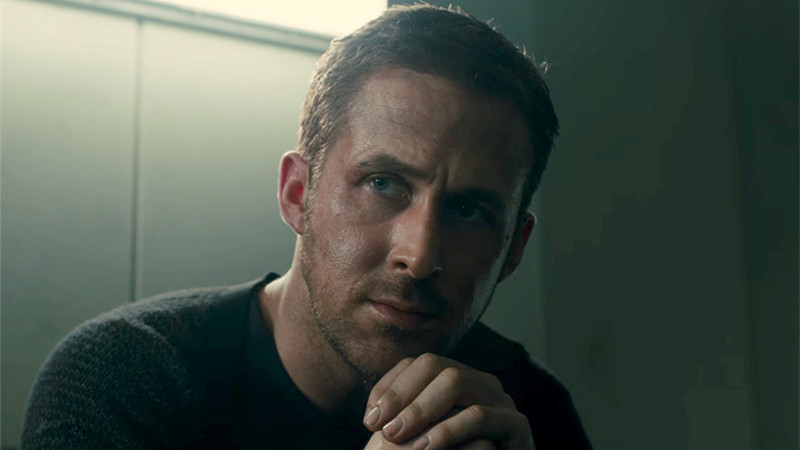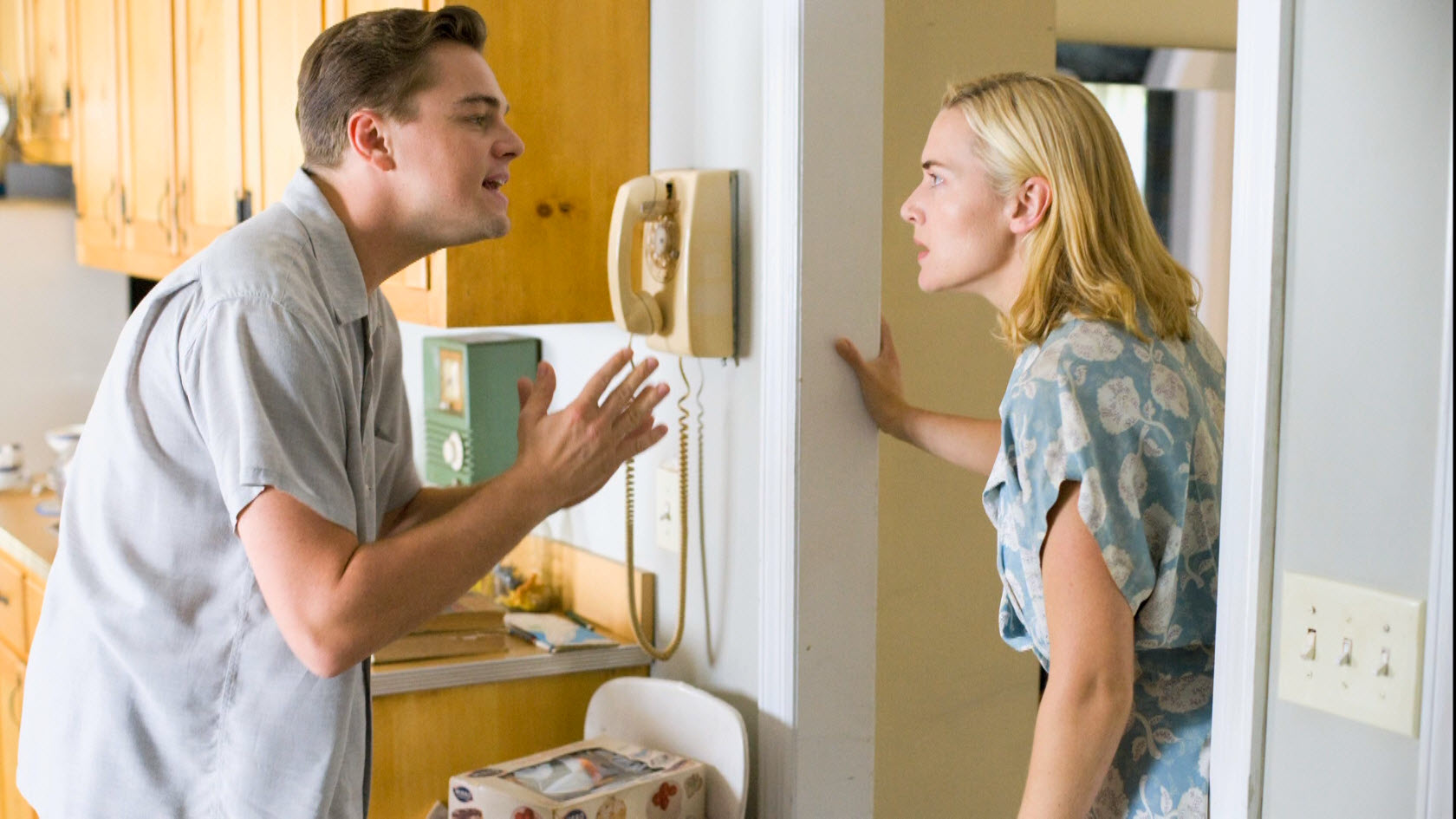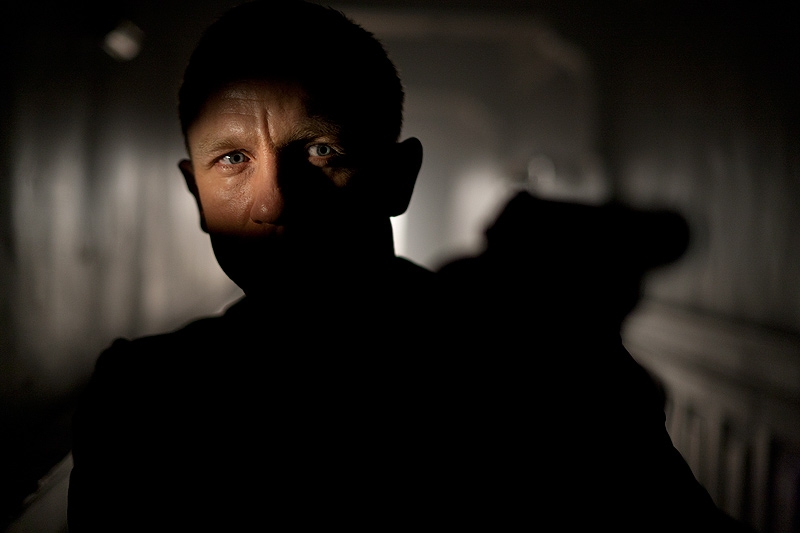6. Revolutionary Road (2008) – Dir. Sam Mendes
This 2008 drama focuses on Leonardo DiCaprio’s Frank and Kate Winslet’s April’s marriage during the 1950s in suburban Connecticut. Emotional and powerful, the film, based on the novel by Richard Yates, is a hard-hitting contrast to countless other dramas about love and romance. Focusing more on the couple’s struggles than their happiness, DiCaprio and Winslet deliver astonishing performances in a film that is both heartfelt and soul crushing all at once.
Again visiting the 1950s, Deakins’ photography changes from warm and inviting (as seen in A Beautiful Mind) to distant and sterile. While undeniably beautiful, the soft white blanket that seems to envelope the film’s pallet is admittedly emotionless and barren, much like many of the altercations between Frank and April.
Interiors always feature varying levels of grey and shadow, while many of the exteriors are often bright, but with a clear and concise use of white light, rather than a warm and radiant yellow hue often seen in other similar pictures. Deakins captures every glance and facial movement of the actors as the unwavering gaze of the camera observes DiCaprio’s and Winslet’s characters’ failing marriage and distant relationship.
7. Skyfall (2012) – Dir. Sam Mendes
In an unusual departure from form, 2012’s Skyfall presented audiences with undeniably the most beautiful Bond flick yet. The film follows Daniel Craig’s James Bond as he tries to unravel a seemingly random attack on Judi Dench’s M by cyber terrorist Silva (Javier Bardem). With locations ranging from Shanghai to Scotland, the story twists and turns as often as the location changes. Taking quiet pauses to reflect on the life of both the characters and the franchise, Skyfall feels both intimate and exciting, solidifying it as one of the best Bond films of the past 20 years.
Featuring a variety of photography throughout, Deakins paints a visually engaging yet simple portrait as Bond races across the globe. Starting in England, the majority of the scenes take place in offices, where white fluorescent lights create a professional and sterile atmosphere appropriate for the jobs at hand. When the story takes a brief detour to Shanghai, Craig’s Bond finds himself atop a neon-lit skyscraper as he follows and confronts a hitman with connections to Bardem’s Silva. Their fist fight is largely composed of silhouettes dancing against the neon backdrop of Chinese advertising.
A maze of mirrors creates a dazzling and disorienting affect as the two try to best one another. In the film’s finale, Bond takes refuge in a gothic mansion in the mountains of Scotland. The lush green landscapes coupled with the dense fog and overcast skies creates an air of mystery and calm before the final show-down with Silva in an amber lit chapel.
8. Prisoners (2013) – Dir. Denis Villeneuve
Hugh Jackman, Jake Gyllenhaal, Paul Dano, and Terrence Howard star in this mystery drama about abduction, morality and the lengths a parent is willing to go to protect his children. When Keller Dover’s (Jackman) and Franklin Birch’s daughters are mysteriously kidnapped on Thanksgiving, a search starts to find the missing girls. But after a suspect is arrested (Dano), and the girls are still yet to be found, Dover takes matters into his own hands as detective Loki (Gyllenaal) races against the clock trying to unravel the mystery of the girl’s disappearance.
The bleak and dreary weather that pervades the film bleeds over into Deakins’ evocative and mute compositions. Although shot in Georgia, the film takes place in Pennsylvania under overcast skies, where the precipitation periodically changes from snow to rain. Much of the story is set in dense, suburban neighborhoods; where the houses cast a claustrophobic and paranoid aura over the tormented characters.
Aside from the opening dinner scene, the majority of the film’s interiors take place in drab and run down houses. Out of date kitchens and bedrooms are the settings for multiple conversations and they create a hopeless atmosphere both for the “heroes” and their victims. Heavy greys and soft blacks meld together to personify the moral grey area the characters occupy for much of the film.
9. Sicario (2013) – Dir. Denis Villeneuve

Sicario is Roger Deakins’ second collaboration with director Denis Villeneuve after “Prisoners.” With an astounding 13 nominations for “Best Cinematography” at the Academy Awards, Deakins still hasn’t won.
For his most recent nomination, Deakins framed every shot with incredible precision, using the ARRI Alexa digital camera almost as an extra character. The audience becomes intimate with the action thanks to it, and the cinematographer’s work adds layers of throbbing intensity that otherwise wouldn’t be achieved.
The artistry displayed here includes creating silhouettes in the desert, embracing shadows and using as much possible natural light simply to raise tension. The Infrared shots managed to bring the audience even closer, seeing the action with the character’s eyes and experiencing the entire nightmare directly.
Something about the rest of the film explains why it’s been said to “lack a higher purpose” and “too cramped in the argument,” which is how the cinematography really stands out as its most imminent quality. Deakins is a household name for film fans everywhere, and it’s understandable that a film he works on might, most of all, underline his talent.
10. Blade Runner 2049 (2017) – Dir. Denis Villeneuve

Working closely with screenwriters Hampton Fancher (who co-wrote Ridley Scott’s original Blade Runner back in 1982) and Michael Green, and his sensational cinematographer Roger Deakins, visionary Canadian filmmaker Denis Villeneuve did the near impossible task of following up Scott’s Blade Runner with a sequel that retains much of the tactile splendor and future noir poetry of the original while manufacturing an objet d’art that is perhaps even more emotionally engaging and narratively a more complete experience.
Unspooling some thirty years after the first film, Ryan Gosling is K, a replicant who hunts rogue replicants and, like Rick Deckard (Harrison Ford, excellent in his best role in decades) before him, retires his quarry using deadly means. When K discovers evidence suggesting that a replicant has reproduced and had a child, he is charged with murdering the child to prevent a replicant uprising.
While 2049 certainly lacks the iconic villains of the original (Jared Leto’s Niander Wallace and Sylvia Hoeks’ Luv are intriguing characters but lack the depth, dynamism, and grandeur of Rutger Hauer’s Roy Batty and Daryl Hannah’s Pris), it still offers up an emotive, stirring, and stunning spectacle. The dystopian future presented onscreen is equal parts gorgeous and ghoulish.
Author Bio: From the Midwest, Emerson Shaw is a student at Purdue University in West Lafayette Indiana. Currently studying engineering, all his free time is devoted to writing, studying, watching, and reading about film. He never planned on becoming obsessed with cinema, but after watching Steven Spielberg’s Catch Me If You Can at age 15, the beauty of the moving picture was ingrained in his mind forever.


